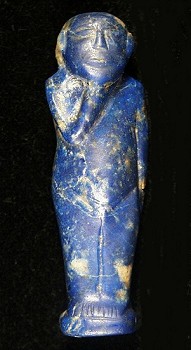
Opaque stone (aluminium and sodium silicate and sodium sulphide) with a dark-blue colour and sometimes white (calcite) or gold (pyrite) flecks. Lapis lazuli was used in Egypt from the Predynastic Period on to make beads, amulets, and scarabs, and as inlay in jewellery, particularly in the Middle and New Kingdoms. All kinds of famous jewellery have lapis inlays, such as the silver armbands of Queen Hetepheres, the mother of Khufu (4th Dynasty), the jewellery from Lahun and Dahshour and the treasure of Tod (all Middle Kingdom), the jewellery of Tutankhamun (18th Dynasty) and of the kings whose tombs were found at Tanis (21st and 22nd Dynasties). Many texts from ancient Egypt mention Lapis lazuli and say that it was obtained in western Asia and in Meroe and Punt. No mines are known in those areas however. Although some people maintain that Lapis lazuli was found in Egypt, it is almost certain that the only source for ancient Egypt was Badakshan in northeastern Afghanistan. The stone then reached Egypt along the trade routes. The classical author Pliny called the stone sapphire.